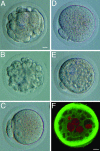Incorporation of the acrosome into the oocyte during intracytoplasmic sperm injection could be potentially hazardous to embryo development
- PMID: 16183738
- PMCID: PMC1242329
- DOI: 10.1073/pnas.0507005102
Incorporation of the acrosome into the oocyte during intracytoplasmic sperm injection could be potentially hazardous to embryo development
Abstract
In mice and humans, a normal offspring can be obtained by injecting a single spermatozoon into an oocyte, the process called intracytoplasmic sperm injection (ICSI). When three or more mouse spermatozoa with intact acrosomes were injected into individual mouse oocytes, an increasing proportion of oocytes became deformed and lysed. Oocytes did not deform and lyse when acrosome-less spermatozoa were injected, regardless of the number of spermatozoa injected. Injection of more than four human spermatozoa into a mouse oocyte produced vacuole-like structures in each oocyte. This vacuolation did not happen when spermatozoa were freed from acrosomes before injection. Hamsters, cattle, and pigs have much larger acrosomes than the mouse or human. Injection of a single acrosome-intact hamster, bovine, and porcine spermatozoon deformed and lysed many or all mouse oocytes. This deformation did not happen when these spermatozoa were freed from acrosomes before ICSI, regardless of the number of spermatozoa injected. Because trypsin and hyaluronidase mimicked the action of acrosome-intact spermatozoa, it is likely that the acrosomal enzymes deform and lyse the oocytes. Injection of small amounts of trypsin and hyaluronidase into normally fertilized mouse eggs disturbed their pre- and postimplantation development. In view of potentially harmful effects of acrosomal enzymes on embryo development, the removal of acrosomes before ICSI is recommended for animals with large sperm acrosomes. The removal of acrosomes may increase the efficiency of ICSI in these animals. Although human and mouse spermatozoa do not need to be freed from acrosomes, the removal of acrosomes before ICSI is theoretically preferable.
Figures


Similar articles
-
Efficient injection of bull spermatozoa into oocytes using a Piezo-driven pipette.Theriogenology. 1999 Nov;52(7):1215-24. doi: 10.1016/S0093-691X(99)00213-7. Theriogenology. 1999. PMID: 10735099
-
Simultaneous removal of sperm plasma membrane and acrosome before intracytoplasmic sperm injection improves oocyte activation/embryonic development.Proc Natl Acad Sci U S A. 2006 Nov 21;103(47):17661-6. doi: 10.1073/pnas.0608183103. Epub 2006 Nov 7. Proc Natl Acad Sci U S A. 2006. PMID: 17090673 Free PMC article.
-
Intracytoplasmic injection of porcine, bovine, mouse, or human spermatozoon into porcine oocytes.Mol Reprod Dev. 1999 May;53(1):84-91. doi: 10.1002/(SICI)1098-2795(199905)53:1<84::AID-MRD10>3.0.CO;2-U. Mol Reprod Dev. 1999. PMID: 10230820
-
Fertilization and developmental initiation of oocytes by injection of spermatozoa and pre-spermatozoal cells.Ital J Anat Embryol. 2005;110(2 Suppl 1):145-50. Ital J Anat Embryol. 2005. PMID: 16101032 Review.
-
Fertilization imaged in 2-, 3- and four dimensions: molecular insights for treating infertility.Ital J Anat Embryol. 2001;106(2 Suppl 2):51-60. Ital J Anat Embryol. 2001. PMID: 11732596 Review.
Cited by
-
Intracytoplasmic Sperm Injection in Cattle.Genes (Basel). 2021 Jan 29;12(2):198. doi: 10.3390/genes12020198. Genes (Basel). 2021. PMID: 33572865 Free PMC article. Review.
-
Ca2+ ionophore A23187 can make mouse spermatozoa capable of fertilizing in vitro without activation of cAMP-dependent phosphorylation pathways.Proc Natl Acad Sci U S A. 2013 Nov 12;110(46):18543-8. doi: 10.1073/pnas.1317113110. Epub 2013 Oct 15. Proc Natl Acad Sci U S A. 2013. PMID: 24128762 Free PMC article.
-
Possible causal factors of structural chromosome aberrations in intracytoplasmic sperm injection of the mouse.Reprod Med Biol. 2009 May 14;8(3):89-95. doi: 10.1007/s12522-009-0017-x. eCollection 2009 Sep. Reprod Med Biol. 2009. PMID: 29699313 Free PMC article. Review.
-
Sperm pretreatment with dithiothreitol increases male pronucleus formation rates after intracytoplasmic sperm injection (ICSI) in swamp buffalo oocytes.J Reprod Dev. 2013;59(1):66-71. doi: 10.1262/jrd.2012-104. Epub 2012 Nov 6. J Reprod Dev. 2013. PMID: 23132520 Free PMC article.
-
Some reflections on intracytoplasmic morphologically selected sperm injection.Int J Fertil Steril. 2014 Jul;8(2):105-12. Epub 2014 Jul 8. Int J Fertil Steril. 2014. PMID: 25083173 Free PMC article. Review.
References
-
- Van Steirteghem, A. C., Nagy, Z., Joris, H., Liu, J., Staessen, C., Smitz, J., Wisanto, A. & Devroey, P. (1993) Hum. Reprod. 8, 1061-1066. - PubMed
-
- Kimura, Y. & Yanagimachi, R. (1995) Biol. Reprod. 52, 709-720. - PubMed
-
- Yamauchi, Y., Yanagimachi, R. & Horiuchi, T. (2002) Biol. Reprod. 67, 534-539. - PubMed
-
- Said, S., Han, M. S. & Niwa, K. (2003) Theriogenology 60, 359-369. - PubMed
-
- Deng, M. & Yang, X. J. (2001) Mol. Reprod. Dev. 59, 38-43. - PubMed
Publication types
MeSH terms
Substances
LinkOut - more resources
Full Text Sources

